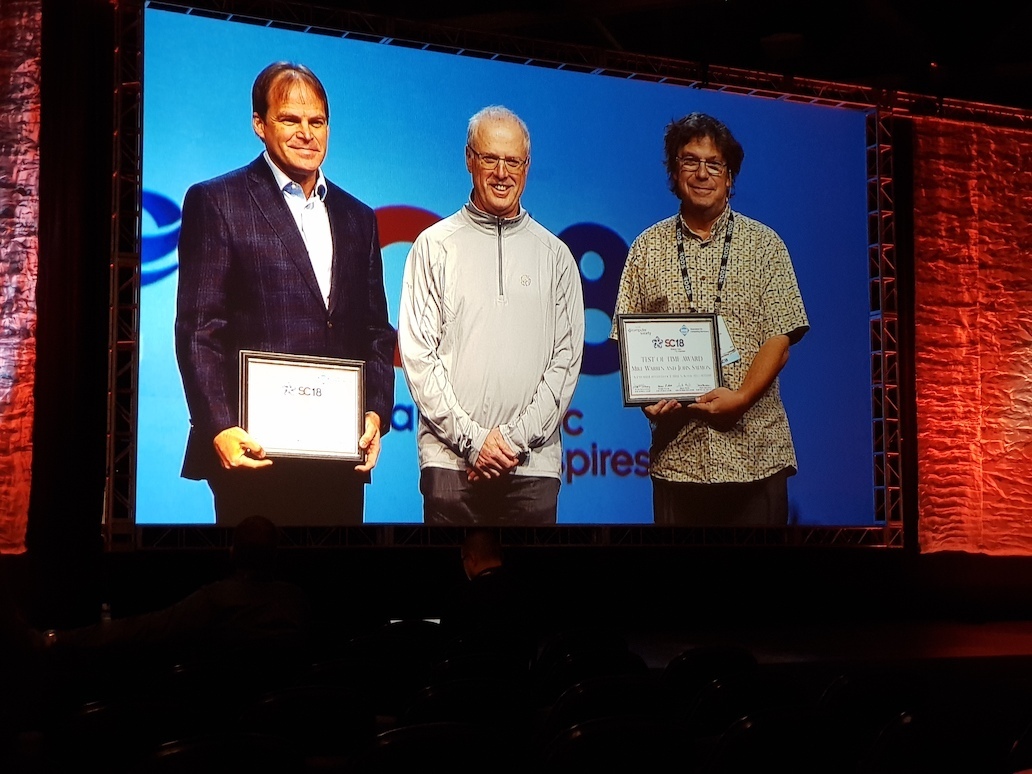
RCC Director Professor David Abramson will co-chair the invited talks committee of SC19, the world’s largest supercomputing conference.
SC19 will be held in Denver, Colorado, USA, 17–22 November 2019.
This month, Prof Abramson attended SC18 in Dallas, Texas. Read his conference report below.
By RCC Director Professor David Abramson
As usual, the annual Institute of Electrical and Electronics Engineers (IEEE) Supercomputing conference was an exhausting and exhilarating mix of talks, presentations, exhibits, and meetings with friends and colleagues.
SC18 was held in Dallas this November, and attracted the typical crowd of thousands.
This was the 30th year of the conference series, and special mention was made of this, including acknowledging the so-called “Perennials” who have attended all 30. Not quite a Perennial, I have attended more than 20, starting in the mid-1990s.
Again, as in recent years, I was accompanied to the conference by UQ Associate Director of Institutes Research Computing Jake Carroll and Irek Porebski, Senior Systems Programmer with UQ’s Queensland Brain Institute. We all learned a great deal about computing systems of interest to the university.
The SC committee often invites a keynote speaker from outside the field, and this provides a good perspective on the, otherwise, deeply technical theme. This year, Prof. Erik Brynjolfsson from the Massachusetts Institute of Technology (MIT) spoke about the disruptive effect of technology on societies, economies and organisations. It was a nice talk that gave some context to the way our supercomputers and applications play out. I recommend looking up his work, including his latest book.
There were some excellent invited talks. It was great to hear my friend Prof. Chris Johnson, from the Scientific Computing and Imaging Institute (SCI) in Salt Lake City, talking about the role of visualisation in scientific computing.
Prof. Steve Furber, from the University of Manchester, UK, followed with a talk on “neuromorphic" computing and described the new SpiNNaker (Spiking Neural Network Architecture) platform, which he founded.
There were also excellent talks on quantum computing, deep learning, and data science, to name a few topics (a complete list of talks is here.)
Next year, I will be co-chairing the invited talks committee, and I am sure we will have great options lined up for SC19.
At SC18, I was delighted to attend the talk by RCC PhD student Mark Endrei. He presented our work on energy management in supercomputers. He did a great job, presenting the results of our collaboration with colleagues at Cray Inc. and Lawrence Livermore National Labs.
Getting a paper accepted in SC is challenging, with a success rate only slightly over 20 per cent.
Another highlight was seeing 12 Australian high school students, and their teacher chaperones, attend the conference. This is a scheme I initiated at Monash University eight years ago with the John Monash Science School, and have expanded it to include two Brisbane-based schools.
See the SC18 report by four Queensland Academy for Science, Mathematics and Technology (QASMT) students — needless to say there was plenty to excite them.
Lastly, it was a great pleasure as chair of the SC Test of Time committee to present the award to US scientists John Salmon and Mike Warren for a paper from SC93 entitled “A Parallel Hashed Oct-Tree N-Body Algorithm”.
The paper describes a technique for solving N-body problems, which arise in a large number of fields from astrophysics to chemistry at both large and small scales.
Importantly, it described novel algorithms that served as an efficient way of solving N-body problems on HPC platforms.
The paper has been, and continues to be, heavily cited. Even though the experimental work was performed on a 512-processor machine, the work is just as relevant to today’s supercomputers with hundreds of thousands of cores.
As instructed, I wore the SC19 jersey to present the award, although I looked like a Star Trek character in it (photo above)!



